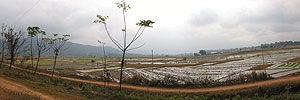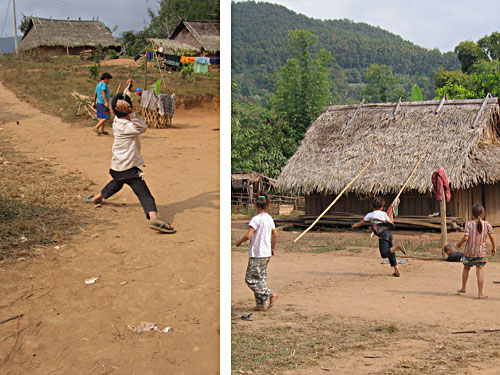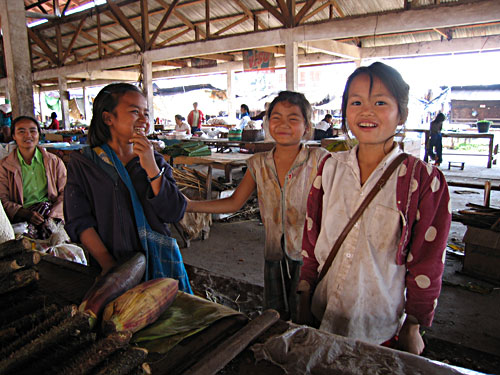
We got up early in Udomxai and had a fairly uneventful ride up to Luang Nam Tha. This time the bus was actually a bus–four sides, widows and a door. After we arrived my Australian friend and I walked around town trying to find reasonable accommodation. Everything seemed to be overpriced, hovering around the five dollar range. This certainly was a lot compared to the $1.50 I had spent only a few nights before in Munag Ngoi. Perhaps because I had a few hours left of sunlight I was incredibly stubborn but eventually found a place with a nice family and the promise of hot showers. It turned out that although there were heaters for the shower it makes no difference when there is no running water. Every time I went to take a shower I was met with a little dribble out of the shower head. I was willing to deal with cold water or even dunking my head under the sink but there was no water at all. Usually I’m happy going around for days without taking showers but you really work up a sweat walking around the dusty roads in Laos. The nights are cold (around 60 degrees) but the days are very hot under the blazing sun (around 90 degrees). Add road dust, exhaust fumes and touching things in the market to the sweat and you end up in a pretty disgusting state. It wasn’t long before I figured out why the large bucket of standing water was sitting next to the sink–so I used it for my incredibly cold, acrobatic showers.
Most people go hiking in Luang Name Tha. I did not. Right around this time I started to realize that, although I tried and pretended, I am not an outdoors woman and do not like to hike. I like going places and seeing things and sometimes those places and things are only accessible by hiking because there are no roads or transportation. I am willing to hike when I have to but I don’t like to hike for the sake of hiking. A lot of the Europeans and Australians I traveled with would search out hiking for the fun of it. The locals were continually confused by foreigners requesting whole day (or longer!) hikes. A symbol of their success is the fact that they don’t have to walk places anymore–that they can afford a motorbike or a car.
I said goodbye to my pro-hiking traveling partners and spent the next three days wandering around the barren town. One day I rented a bicycle and rode North to visit local tribal villages. There are a number of different tribes in the area, many of which are accessible by bicycle on your own. The first village I went to was supposed to have a craft center where foreigners can buy embroidered clothing, jewelry and souvenirs. I did not find anything resembling a craft center but I did find a lot of pigs and dogs wandering the dusty tracks. I rode around the tiny village and finally stumbled around a dead end where two groups of children were playing. The group of boys were throwing wooden tops attached to strings against the ground. There seemed to be some sort of system of winning where a player tried to knock another player’s top off the road–similar to bocce. The group of girls were playing a popular game in Laos were they jump over a stick or string. It sounds silly but they appear to get hours of enjoyment out of it. Remember that most of these villages don’t have electricity or money for toys so they play with what they have available to them.

Local tribe boys playing spinning tops and girls jumping over sticks.
I stayed and awkwardly watched the children playing for a while because I had read that it was impolite and frowned upon for a stranger to enter a village without stopping. This superstition has something to do with evil spirits which are still quite feared by the villagers. I continued on, up more dirt road hills than I cared to, and finally found the Lantaen Tribe village where they guard a waterfall. I wasn’t too interested in the waterfall but paid the small entrance fee to help support the locals. The young woman–a teenager probably–who was selling tickets wore the traditional costume I’d admired on the women around town. It consisted of a dark blue or black top and skirt with red trim. The top was fastened on the side, Chinese-style and the skirt fell above the knee. Around her calves were white strips of fabric, wrapped around to cover her exposed legs like the bandages on a cartoon mummy. These type of coverings are usually used to protect the legs from scratches when working in a field or walking through a forest. Her eyebrows were completely plucked and hair was fastened in a bun on top of her head. Holding the bun in place was a silver rod adorned with a large French Indochina coin with smaller coins dangling onto her forehead.
Although I knew it was wrong to take away antiques of local costume I desperately wanted a silver bobble of my own. The girl took it out of her hair for me to admire and a local man helped to translate. They wanted what amounted to around $20 for the piece, which I thought was too much. Actually, I should have taken the deal since it was pure silver and was certainly worth more than that. I had learned in the past to take opportunities when you can but I didn’t go through with it. Later in the week my Australian friend, back from her hike, tried to negotiate for one on my behalf and was scared away by a disapproving grandmother. In the end it would have been wrong to buy a family heirloom like that even if it was a fair price. I don’t want to encourage such a beautiful, and nearly extinct, culture to trade their heritage for money to buy Western clothes with.
Lantaen Children Playing from Megan Kearney on Vimeo.
Most of my evening meals in town were eaten at the local Indian restaurant. Surprisingly, it was owned by an Indian. I liked the fact that he knew that I didn’t like spicy food and to bring me a cold Beer Lao when I sat down–I became a regular after only two visits. Unfortunately, it was hard to get through dinner without being harassed by the local Akha women. None of the hill tribes live in town. Instead, they commute from their villages in the early morning and return in the late evening. Therefore, I was worried about these middle aged women who hung around town until all of the foreigners went to bed. The Lantaen tribe, who I mentioned earlier, only comes into town to buy and trade at the market but many of the Akha women come in to specifically sell to tourists. Their lifestyle completely changed when they decided to forego farming to sell bracelets to foreigners. Because tourism in Northern Laos has only gained popularity in the past few years, this change in the Akha culture must have happened very recently. A few of them appear to be having fun with the tourists but mostly it’s just sad to watch. It’s interesting how much more commercialism has been embraced by the Akha in every country to a much greater extent than any other tribe.
After a few days of wandering around town I ran out of things to do. I went to the local museum where the ticket taker was asleep underneath the ticket booth. It was pretty depressing as far as museums go (smelling like my basement didn’t help) but there was a good selection of local costumes–one of my main interests. I also hung out in the run down park located across from a number of abandoned buildings. The most interesting spot I found was on the Eastern side of town where a river separates Luang Nam Tha from outlying villages. When I first arrived, in late afternoon, the spot was completely empty. I was relieved to find a picturesque place to sit and write in my journal. After only a few minutes villagers started walking past me–seemingly on the commute home. A few people came out from the other side of the river with their plastic baskets and soap to wash for the day. The women wore a sarong fastened above their chest and men stripped down to briefs. Children under 10 ran around in the nude, playing more than washing. Soon school let out and a rush of kids in blue bottoms and white tops ran across the bamboo bridge. A husband and wife pulled their brand new pickup truck into the river in-between the bathers and proceeded to wash it. Everyone down river had to dodge dirt and oil for the remainder of the afternoon.

Kids playing with me at the Luang Name Tha market.
I also headed down to the market–a very dirty, large building–to see the local tribes. However, I only saw a handful of Akha and Lantaen women on their way home from buying supplies and selling brooms. The kids working the market had a lot of fun with me. After they figured out how my camera worked we played the game “make Megan take pictures of random vegetables.” It goes like this: They would point at some eggplants and giggle. I’d take a picture. They’d then crowd around me and look at the picture and giggle. Repeat.
Children in the market from Megan Kearney on Vimeo.
You can see the photos from Luang Nam Tha here.